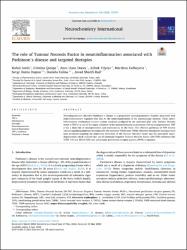| dc.contributor.author | Durna Daştan, Sevgi | |
| dc.date.accessioned | 2023-04-13T13:44:50Z | |
| dc.date.available | 2023-04-13T13:44:50Z | |
| dc.date.issued | 2022 | tr |
| dc.identifier.uri | http://dx.doi.org/10.1016/j.neuint.2022.105376 | |
| dc.identifier.uri | https://hdl.handle.net/20.500.12418/13689 | |
| dc.description.abstract | Neurodegenerative disorders Parkinson’s disease is a progressive neurodegenerative disorder associated with
neuroinflammatory responses that lead to the neurodegeneration of the dopaminergic neurons. These neuroinflammatory mechanisms involve various cytokines produced by the activated glial cells. Tumour Necrosis
factor α (TNF α) is one of the major mediators of the neuroinflammation associated with neurodegeneration. TNF
α has a dual role of neuroprotection and neurotoxicity in the brain. The effective pathways of TNF involve
various signalling pathways transduced by the receptors TNFR1 and TNFR2. Effective therapeutic strategies have
been produced targeting the neurotoxic behaviour of the Tumour Necrosis Factor and the associated neurodegeneration which includes the use of Dominant Negative Tumour Necrosis Factor (DN-TNF) inhibitors like
XENP 345 and XPro®1595 and peroxisome proliferator receptor gamma (PPAR-γ) agonist | tr |
| dc.language.iso | eng | tr |
| dc.publisher | neurochemistry international | tr |
| dc.relation.isversionof | http://dx.doi.org/10.1016/j.neuint.2022.105376 | tr |
| dc.rights | info:eu-repo/semantics/openAccess | tr |
| dc.title | The role of Tumour Necrosis Factor in neuroinflammation associated with Parkinson's disease and targeted therapies | tr |
| dc.type | article | tr |
| dc.contributor.department | Fen Fakültesi | tr |
| dc.contributor.authorID | 0000-0003-4946-5602 | tr |
| dc.identifier.volume | ocak 2022 | tr |
| dc.identifier.issue | 158 | tr |
| dc.identifier.endpage | 29 | tr |
| dc.identifier.startpage | 1 | tr |
| dc.relation.publicationcategory | Uluslararası Editör Denetimli Dergide Makale | tr |
















